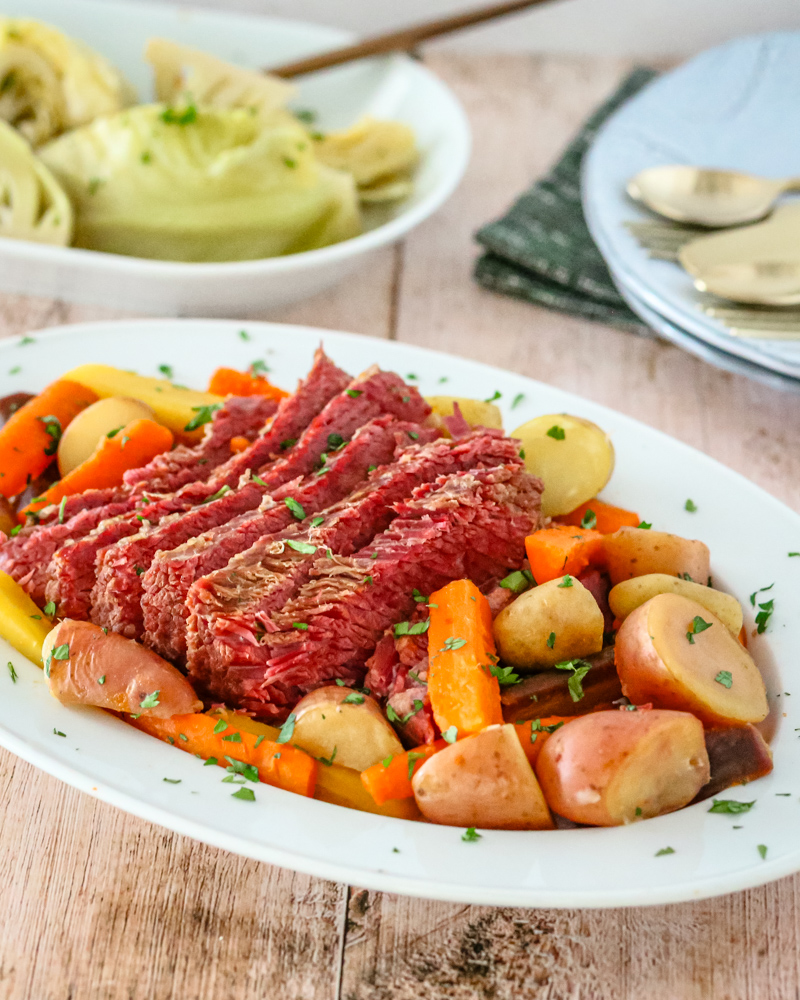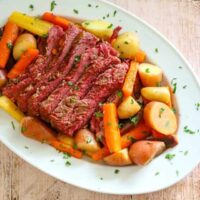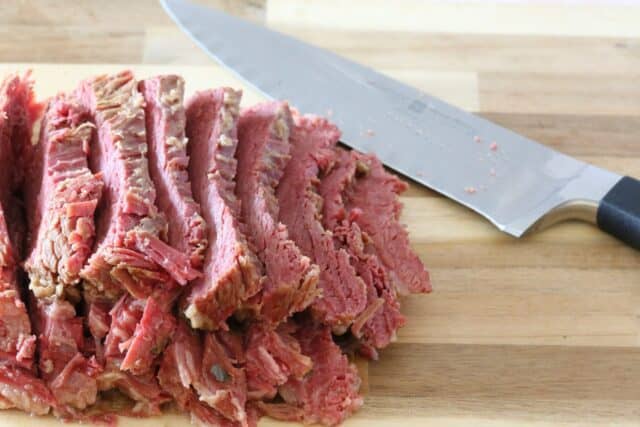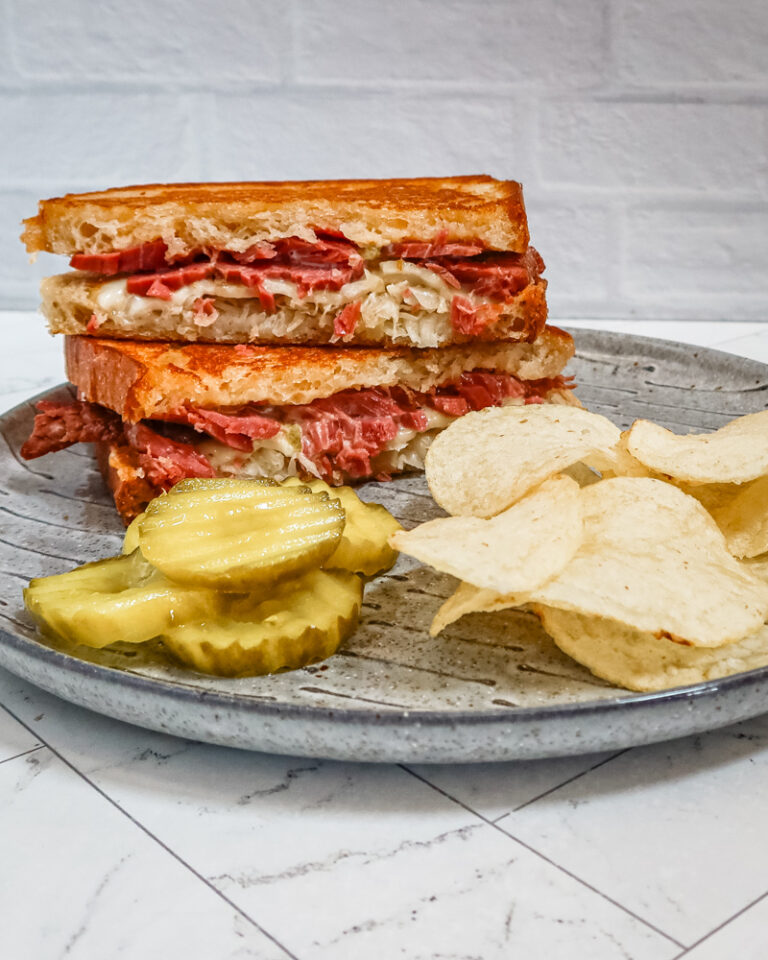Ultimate Corned Beef and Cabbage
This corned beef and cabbage dinner is sure to please everyone, even your pickiest eaters. You don’t have to wait for St. Patrick’s Day to enjoy this wonderful boiled dinner!

Corned beef and cabbage may be considered the iconic St. Patrick’s Day meal in the U.S., but its roots are in Irish-American tradition rather than old Ireland. Irish immigrants in New York adopted corned beef—readily available from Jewish butchers—as a stand-in for the cured pork they were accustomed to back home. Cooked with cabbage and vegetables, the salty, savory meat became a beloved comfort food that reminded them of bacon and cabbage dinners.
This classic boiled dinner is still a favorite today, especially in March. It’s hearty, satisfying, and perfect for feeding a crowd. The corned beef simmers gently until fork-tender, while the vegetables absorb all the savory flavor from the broth. Whether you make it for a holiday or just because you’re craving something cozy and traditional, this version is as reliable as it is delicious.
What You’ll Like About This Dish
Classic comfort food. A time-tested dish with meat, potatoes, and veggies in one pot.
Feeds a crowd. Makes a generous amount—great for holidays or leftovers.
Customizable. Swap in parsnips, rutabaga, or different potato varieties to make it your own.
Traditional flavor. A homemade spice bag (bouquet garni) ensures depth and aroma without fuss.
Ingredient Notes
- Corned beef brisket: Choose a flat cut for easier slicing, and rinse well to reduce saltiness.
- Whole spices: A bouquet garni with peppercorns, allspice, garlic, bay leaf, and thyme adds flavor without overwhelming the broth.
- Beef broth and water: Simmering in broth deepens the savory flavor of the meat.
- Potatoes: Red-skinned hold their shape well—Yukon golds or white potatoes are good swaps.
- Carrots and rutabaga: Add natural sweetness and texture. Rutabaga is optional but highly recommended.
- Cabbage: Added at the end so it cooks until tender but not overdone.
- Butter and mustard: Optional but traditional accompaniments for richness and zing.
- Parsley: A fresh garnish to finish.
Steps to Make Corned Beef and Cabbage
- Rinse the corned beef and place it in a large Dutch oven or stockpot.
- Prepare a bouquet garni with the whole spices and garlic, and add it to the pot.
- Pour in the beef broth and enough water to cover the brisket.
- Bring to a boil, then reduce heat and simmer until the meat is tender—about 2½ to 3 hours.
- Add onions, potatoes, carrots, and rutabaga (if using) and simmer 20 minutes.
- Add cabbage wedges and continue cooking 15 to 20 minutes, until the vegetables are tender.
- Remove the meat and let it rest 15 minutes, then slice across the grain.
- Arrange the sliced beef and vegetables on a platter, drizzle with broth, and garnish with parsley.
Tips for Success
- Rinse the corned beef before cooking to avoid overly salty broth.
- Use cheesecloth or a spice bag to contain the bouquet garni for easy removal.
- Let the meat rest before slicing to retain juiciness.
- Slice against the grain for tender bites.
- Serve with mustard or horseradish sauce for a flavorful finish.
Recipe Variations
- Use multicolored carrots. Adds a visual pop and subtle flavor variation.
- Swap potatoes. Yukon Gold or round white potatoes are great low-starch alternatives.
- Add parsnips. Peel and cut into chunks; cook them with the carrots.
- Try rutabaga. Slightly sweet and earthy, it complements the corned beef beautifully.
- Spice it up. Add a pinch of crushed red pepper to the broth for gentle heat.
Serving Suggestions
- Serve with prepared mustard or a quick horseradish sauce.
- Add butter to hot vegetables just before serving for richness.
- Pair with soda bread or rye on the side.
- Slice leftovers thinly for Reuben sandwiches or hash.
How to Store
Refrigerate: Store leftover corned beef, cabbage, and vegetables in shallow, airtight containers within 2 hours. Use within 4 days.
Freeze: All parts of the meal may be frozen in airtight containers or freezer bags. Label and freeze for up to 3 months. Thaw overnight in the fridge before reheating.
To Reheat: Warm gently on the stovetop in broth or in the microwave. Avoid overcooking the vegetables when reheating.

Ultimate Corned Beef and Cabbage
Ingredients
- 8 whole allspice
- 1 teaspoon black peppercorns
- 2 cloves garlic, bruised
- 2 large bay leaves
- 3 sprigs thyme or 1/2 teaspoon dried leaf thyme
- 4 pounds corned beef brisket
- 3 cups beef broth
- Water to cover
- 2 medium onions, cut into wedges
- 3 pounds potatoes, red-skinned, scrubbed and quartered
- 4 large carrots, halved lengthwise and cut into 3-inch lengths
- 1 small rutabaga, peeled and cut into 1 1/2-inch cubes, optional
- 1 head green cabbage , cut into 6 to 8 wedges
- Chopped fresh parsley, for garnish
- 4 tablespoons butter, for serving
- Mustard, for serving, optional
Instructions
- Rinse the corned beef and place it in a large Dutch oven or stockpot.
- Make a cheesecloth bag and add the allspice berries, peppercorns, garlic, bay leaves, and thyme sprigs. Tie with kitchen twine and add it to the corned beef.
- Add the beef broth to the Dutch oven along with enough water to cover the corned beef. Place the pot over medium heat and bring to a boil. Reduce the heat to low, cover the pot tightly, and simmer until the corned beef is tender, about 2 1/2 to 3 hours.
- Add the onions, potatoes, carrots, and rutabaga; if using, increase the heat to medium and bring to a boil. Reduce the heat to low and simmer, covered, for 20 minutes. Add the cabbage wedges to the pot and continue to cook for about 15 to 20 minutes until the cabbage is tender.
- Remove the corned beef to a cutting board and let it stand for 15 minutes. Slice the meat across the grain and transfer it to a platter.
- Strain the broth in a gravy separator and discard the fat.
- Arrange the vegetables around the corned beef and drizzle with some of the cooking broth. Garnish with chopped fresh parsley.
Nutrition
Disclaimer:
Our nutritional information is based on a third-party application that analyzes the ingredients list to determine the values. The information is meant to be helpful, but should be considered an estimate. Values may differ depending on measurements, brands, serving variations, and database availability.



